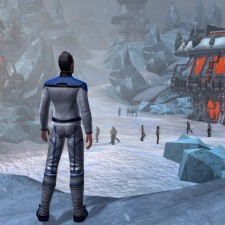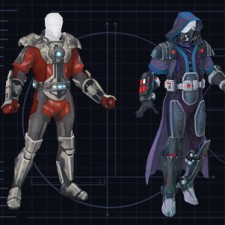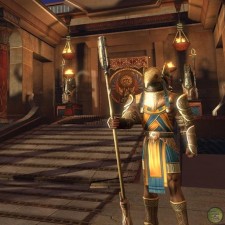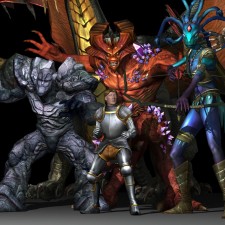IP-based games have a significant downside. If someone doesn’t like, say, the Twilight books and movies, news of your new Twilight MMO isn’t going to get them excited. Or even worse — the game could be so focused on shoehorning every bit of the IP into the game that it forgets to build any fun in; ALL it is, is the IP. This has long been a weakness for IP-based videogames from the Empire Strikes Back Atari 2600 cartridge way back in the 80s. You just kept shooting AT-AT walkers on Hoth, again and again and again.
| Game: Star Trek Online | IP: Star Trek |
 Veteran TV writer Gene Roddenberry initially pitched Star Trek as “Wagon Train to the stars”*. In Star Trek, the crew of the USS Enterprise would be far from home in the frontier of deep space, having to operate more or less on their own and take on challenges that could threaten the galaxy using nothing but their own determination and a worn out old deflector dish. As a show set in the future, Roddenberry felt Star Trek had the ability and the responsibility to show humanity as having progressed from its warlike past. Star Trek was the first show to televise an interracial kiss and throughout its three season run, focused as much on social issues of the day as it did on starship battles. Star Trek has spawned eleven movies, a cartoon, four spin-off TV series, dozens of books and video games, and much much more. Distilling all this history into an MMO would be a daunting task for any company. Perpetual Entertainment gave it a try and failed. The license was passed to Cryptic Studios, developers of Champions Online, and earlier this year they released Star Trek Online to a skeptical reception. Focusing largely on combat and very little on anything else, most players praised the game as a space battle simulator, but had less kind things to say about the ground portions of the game. That said, there was significant praise for their bridge officer mechanic — NPCs under your control who level and gain skills as you do. Since its launch, Cryptic has been busy adding content to the high-end game, but the experience is still very linear. The game is set after the events of the most recent film, but in the original timeline. I don’t know if that timeline is the one where Voyager returned after thirty years, or the one after Admiral Janeway returned through time and helped bring Voyager home after only seven using future technology. * Wagon Train was a long running western where a wagon master and his crew of scouts and guards would guide a wagon train through Indian country and other dangers to California, then ship back East and do it again. |
|
| Game: Star Wars Galaxies | IP: Star Wars |
 When George Lucas conceived of his future world of water farmers and space wizards, there’s no way he could have foreseen what a media empire it would become. The tale, closely modeled after “The Hero with a Thousand Faces“, Joseph Campbell’s look back at the enduring myths and archetypes of humanity, and the films of Akira Kurosawa, follows a young boy as he discovers his power and destiny: to defeat the evil emperor in his dark castle and bring peace to the kingdom. The original movie has spawned six sequels, two television series, countless books, and a toy and media empire that may be, in the end, Star Wars’ greatest legacy. Star Wars Galaxies was the second MMO developed by Verant Interactive and published by Sony Online Entertainment. Their first MMO, EverQuest, redefined the still new MMORPG industry, and set high expectations for SWG. The game was initially set for 2001, but was delayed until June of 2003, with the expansion that allowed space combat a year later. Set between the events of The Empire Strikes Back and The Return of the Jedi, players could live the life of a citizen of the empire, or take sides and join the Imperial Army or the Rebel Alliance, which would flag them for PvP if they acted overtly for their side. SWG boasted the most open world of any to date, with players able to craft nearly anything that existed in the game, including entire towns and cities. Players could meet and interact with almost every NPC of note from the movies, build and fly a Corellian freighter on trading missions or just set up shop somewhere in a city and design clothing. Though the game had many devoted fans, players were expecting a MMO with more direction, much more like EverQuest and the other MMOs of the day (except, significantly, for Ultima Online, the previous MMO from SWG creative director Raph Koster). The method whereby a player could enable Jedi Knights for their account was initially unknown and (some claimed) not in the game. In a clear attempt to realign the game to be more similar to EverQuest and the newly released World of Warcraft, LucasArts and SOE revamped the game to have specific classes with specific abilities, based on the archetypes of the characters in the movies. This angered devoted fans and can still invoke nerdrage. Nonetheless, Star Wars Galaxies remains SOE’s second most popular subscription MMORPG, after its current flagship, EverQuest II. |
|
| Game: Star Wars: The Old Republic | IP: Star Wars |
 Interested in exploring the Star Wars universe well before the time depicted in the seven movies, Bioware published Knights of the Old Republic in 2003 for the PC and the XBox. KotOR started with the standard trope of an amnesiac character who must struggle to remember their own past. Action started on a starship under attack, and ended with your character in full command of their magical powers and facing a dark figure from their own past. KotOR featured a strong story and semi-real time combat. Depending on choices made during gameplay, your character would become a good Jedi or an evil Sith. The game was a hit on both the XBox and the PC and is considered “… one of the most influential works of the Star Wars Expanded Universe”. Set thousands of years before Star Wars Galaxies, in a time when magic was more common and wizards both light and dark walked openly in the world, Star Wars: The Old Republic is rather more free to define the events of its milieu. Players will choose between various flavors of Sith and Jedi, or take on the roles of smugglers, bounty hunters, spies and other similar professions. Like DC Universe Online, players will be able to fill any of the traditional MMO party roles of tank, healer or damage. Unusual* among MMOs, SWTOR will have a strong storyline for each of the game’s classes that will feature full cinematics and voice acting and take the player through the entire game, giving the player reason to try out new characters to experience all the storylines. If the player is grouped with another player during the storyline missions, the other player is seamlessly incorporated into the dialog. Bioware’s reputation for story and general excellence makes SWTOR the most hotly anticipated MMORPG of 2011. * Final Fantasy XI Online also has a strong, cinematic story line. However, the user has no control over the events of the story, and the story is the same for all jobs. |
|
| Game: Stargate Worlds | IP: Stargate SG-1 |
 Based on the 1994 movie Stargate, Stargate SG-1 took place starting a year after the events of the movie and followed the adventures of a team of military and scientists tasked with exploring the interstellar stargate network and protecting Earth from the dangers of a hostile galaxy. Aired for ten years, Stargate SG-1 is the West’s longest continuously produced SF television series. SG-1 spawned two spinoff television series and a number of direct-to-DVD movies. In 2006, Cheyenne Mountain Entertainment announced they would be producing an MMORPG set in the milieu of Stargate SG-1. Players would (as in post-NGE Star Wars Galaxies) choose an archetype for their character based on prominent characters from the television show. Beset, however, by delays and financial trouble, CME tried to produce a single player version of SGW to keep the license alive, but in March, 2010, CME was forced into receivership and production of SGW was stopped. |
|
| Game: Ultima Online | IP: Ultima |
 Starting in 1980 with Ultima I and continuing through 1999’s Ultima IX: Ascension, Richard Garriott’s groundbreaking RPG series went beyond the standard hack-and-slash paradigm of the day to games with a deep plot and difficult moral quandaries. The release of a new Ultima was as much an event as the release of a new Halo or Grand Theft Auto is today. Innovations such as isometric 2.5D rendering and party-based groups influenced all the RPGs to come. In 1997, Origin Systems release Ultima Online, a MMORPG version of its games set in the land of Brittania and featuring the same 2.5D isometric tile system as many of its later games. It quickly rose to prominence in the nascent MMORPG field, easily trumping its main competitor, Meridian 59, a MMO that featured software-rendered 3D graphics. UO featured full PvP away from the city areas, player housing, a wide variety of trade skills, ships, exploration and a strong community. The release of Verant Interactive’s EverQuest in 1999 (itself a 3D game similar to Meridian 59 but requiring hardware accelerated rendering) meant trouble for UO. As a largely non-PvP game, EverQuest was largely free of the incessant griefing, allowing players to go about their business without fear of other players.* In 2000, UO split the game into the parallel worlds of Felluca and Trammel; in Trammel, no player could attack another player. The majority of the UO playerbase soon migrated to Trammel. In 2001, UO released a 3D client comparable to EverQuest’s. Ultima Online has been in continuous development since its launch and still thrives today as one of Electronic Arts’ stable of MMOs, which include Warhammer Online (more about that tomorrow) and Dark Age of Camelot. * Except for training and other nasty behavior. |
|
Well, that was a long one. We finish up tomorrow with the last three IP-based MMOs in the list: Warhammer Online, Ys Online, and the biggest, baddest of them all — World of Warcraft.

Yo, Ultima Online pre-Trammel, that was a MMO were men were real men, and all women were also men! Most men at this time were rather young. 🙂
BTW, as you took the gaming IPs of UO and WoW into the IP-based MMOs series, I just had to wonder which MMO actually was not based on an IP.
EverQuest 1 probably? – EverQuest 2 would be part of the EQ1-IP in this case.
EQ, Horizons, Asheron’s Call, Anarchy Online, Dark Age of Camelot, Shadowbane … bunches! Plus, all those hundreds of generic fantasy worlds from Asia, or the countless martial arts MMOs (also from Asia) based apparently on “martial arts masters set in ancient China”.